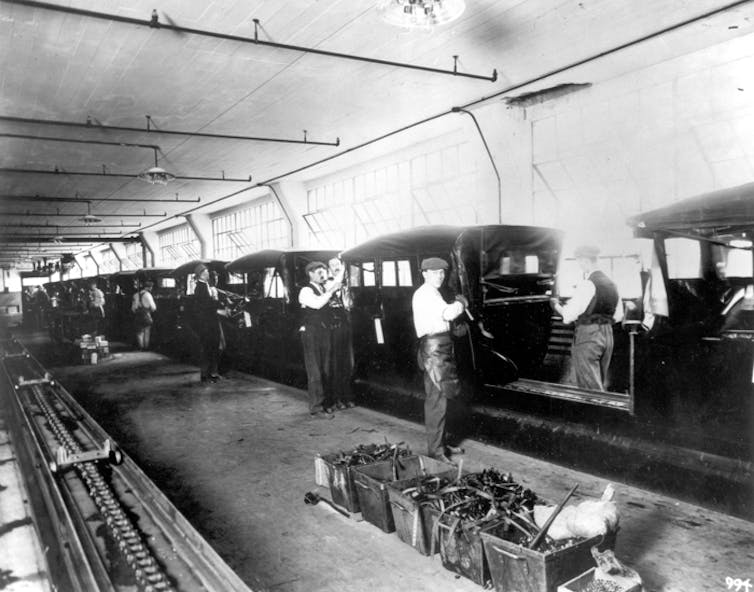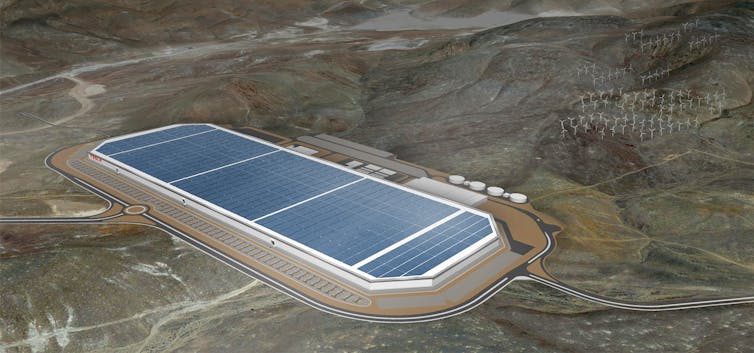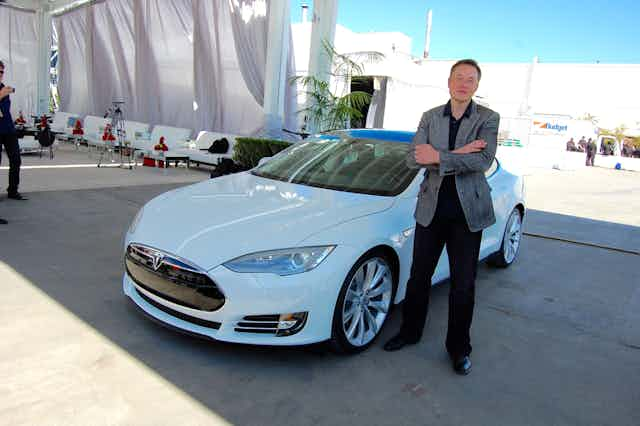The share price of Tesla Motors shot up this week after a financial analyst said that the electric vehicle maker is “uniquely positioned to dominate” the auto industry.
Is Tesla, with its tightly integrated supply chain, following the strategy of another one-time dominant automaker – the Ford Motor Company – of over 100 years ago? Can it revolutionize the world by making an affordable electric car for the masses, much the way Henry Ford did with the Model T in 1908?
Henry Ford took control of his supply chain and made his own parts rather than buy from suppliers, which gave the company the scale needed to improve performance and lower costs. Now Musk is building a new “giga” battery factory, giving Tesla more control over this strategic component. Will it work out the same as for Ford?
Putting Ford in the black
In his 1926 book, Today and Tomorrow, Ford claimed his integrated approach was the key to his success (“if you want it done right, do it yourself”). In fact, he claimed to mine iron ore in Minnesota, ship it to the famous River Rouge facility in Detroit and have it sitting as a Model T in a Chicago driveway in 84 hours! However, at the time, complete standardization (yes, Ford is said to have stated “You could have any color you wanted as long as it was black”) was necessary to make this happen. No options were available as they are for today’s cars, but standardization led to lower prices.

Prior to the Model T, the typical car’s sticker price would often hit US$2,000, or almost five years of wages, which put cars out of reach for all but the rich. Working to make his car affordable, Ford sold the Model T for $260 by 1926, leading to massive market share – over 50% of the automobiles on the road worldwide were Ford’s.
Ford also paid his workers a startling $5 per day to reduce employee turnover.
By this time the average working household income had reached about $1,300 per year. That put the Model T at two to four months of a typical factory worker’s wages, something comparable to or less than today’s economy car!
Huxley’s Brave New World and Fordism
Ford’s significance can even be seen in Huxley’s classic futuristic science fiction work Brave New World from 1932. Huxley anticipated a world with intercontinental rocket plane travel and TV networks, in vitro fertilization, cloning and genetic engineering. Huxley also saw Ford’s approach to be so central to the future that Fordism – Ford’s system of mass production – would become the primary religion!
Huxley correctly saw so many things to come, yet clearly we don’t all worship Henry Ford today. So why did this prediction not come true? Maybe it is because not long after the book was written, the growing design complexity of cars and the demands of customers made Ford’s black-only Model T no longer competitive.
To offer multiple lines of vehicles and options, Ford’s integrated supply chain had to be broken into separate companies supplying specialized sets of products. No one company could handle it all.
Yet by the 1980s, local area networks meant computers could autonomously control machines and make multiple products from the same facility at relatively low costs. Then in the 1990s, the internet made physical proximity unnecessary for achieving economies of scale since manufacturers didn’t need to control every component in the supply chain.
What Huxley missed, in other words, was the impact of computers and IT innovations, considered one of the key facilitators to modern supply chain management.
What can Musk learn from Ford?
Let’s roll the clock ahead 100 years. Elon Musk and Tesla Motors are looking to bring the electric car to the masses much the way Ford did with the Model T.
Parallels include decisions to build a “giga” factory to make batteries that are currently sourced from Panasonic in Japan, paying a premium wage to workers to reduce turnover, and planning to make an electric vehicle priced for the mass market – the upcoming Model 3.
Even model names – Tesla sells the Model S and soon the Model X – may be more than coincidental. Will it work for Tesla the way it worked for Ford? Does today’s technology allow Tesla to do even more than Ford?
The battery pack is the single most important and expensive component in an electric car. A battery can exceed $15,000 per vehicle (or $500 per kilowatt-hour of capacity). The Nissan Leaf electric car has a 24 kilowatt-hour battery and has an average range of 84 miles.
Some industry experts believe batteries need to cost about $100 per kilowatt-hour and have almost triple the current range to be truly mass market. Achieving that sort of reduction in cost and improvement in performance comes from manufacturing at greater scale, rather than relying to suppliers.
In other words, as Tesla makes more batteries, it gains more opportunities to refine production and product design.
Ford found that out, and Tesla will as well. It plans to use most of the “giga” factory capacity in Reno, Nevada to supply Tesla’s auto assembly plant in Fremont, California, but also make batteries for utilities, homes and businesses.
Because there are common battery designs and production, Tesla will be able to transfer any product and process improvements between batteries for vehicles and the grid. Tesla estimates that they will reduce battery costs by over 30% with the “giga” factory.
Claims that Tesla with pay an average of $25 per hour in Reno have not been confirmed by the company, but the ability to retain high-caliber workers is necessary to leverage the accelerated experience that comes from scale into lower costs and improved design. Ford demonstrated that a long time ago. Tesla appears to have learned that lesson.
What will it take to be the Next Model T (or Model 3!)?
Musk’s public goal of 500,000 cars per year and a $35,000 price tag on the Model 3 will need every bit of output and resulting innovation the “giga” factory creates. Ford’s limitations in communicating along his supply chain meant very little variation in what was done or how things were done.
Today, models for left side driving, back seats big enough for customers who want a chauffeur, a third row of seats, four doors, two doors: all add volume but unfortunately bring complexity as well. Today’s computer-controlled process technology makes design variety much more scalable than in 1920. Research and practice show that now, the ability to collaborate with others (within or outside of Tesla) makes physical proximity moot as well.

Unlike Ford, Tesla can use a global supply chain to make a wide variety of products while still pursuing the cost benefits of large-scale manufacturing. At the same time, Tesla can focus on making in-house “core” components, like batteries, with high learning and innovation potential.
Henry Ford had to control it all because even a missing hubcap could stop the line. Musk can now choose to outsource the more commodity-like components where the potential for process or product design improvement is small.
Not there yet
Musk has increased production from 10,000 vehicles in 2012 to a projected 50,000 by the end of 2015. However, forecasts and supply issues for a variety of parts (especially batteries) are causing scheduling hiccups, which has made Wall Street anxious.
While the new “giga” factory coming online in the next couple of years (and others like it) may help achieve many of the needed performance and cost objectives, Tesla is not there yet. Here are three things the company needs to remember to achieve its goal of mass-market electric cars:
First, keep your eye on the core aspects of your business that define your competitive strategy. Tesla making their own batteries fits their strategy of a high-performance, low-cost electric car for the masses. Accumulating experience here moves them toward both volume and cost goals. These are both defined criteria necessary and sufficient for strategic success.
Second, avoid allocating resources to noncore aspects because the payback is not there. Shortages or failures in hubcaps or trunk carpeting are as much problems now for Tesla as for Ford. But you can outsource to supply chain partners far more easily now than then.
Finally, new products or variations of existing ones should be consistent with maintaining your core competency. That is the key to transferring innovation. If adding scale through color choices or design combinations can add to accumulated experience in the core areas without unnecessarily adding to the burden of complexity, great!
Ford’s view on color choice is no longer relevant. But Tesla’s Musk can still learn from Henry Ford’s strategy of making strategic components. Making batteries for home and business can help Tesla fuel more innovations in car batteries and vice versa.

